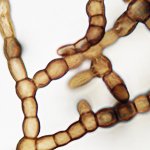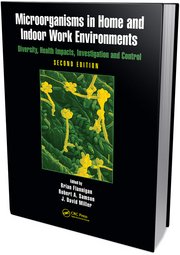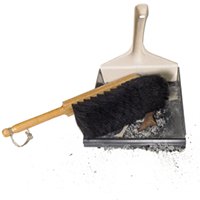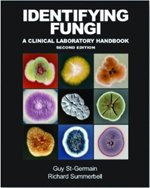US Joint Genome Institute releases Baudoinia sequence
Published: July 26th, 2011
Revised: July 26th, 2011
 The US Department of Energy Joint Genome Institute (JGI) today released the full, annotated genome sequence of Baudoinia compniacensis, a fungus we discovered that was featured in the June 2011 issue of WIRED MAGAZINE. This extremophilic sooty mold is the prominent pioneering species in the primary successional community known as “warehouse staining”, where darkly pigmented microbes form dry biofilms on outdoor surfaces periodically subjected to low level exposure to ethyl alcohol vapour, such as those around distilleries, spirit maturation facilities (“bond warehouses”) and commercial bakeries. Sporometrics worked closely with JGI throughout the project, developing protocols and supplying high quality genomic DNA and total RNA for the sequencing project.
The US Department of Energy Joint Genome Institute (JGI) today released the full, annotated genome sequence of Baudoinia compniacensis, a fungus we discovered that was featured in the June 2011 issue of WIRED MAGAZINE. This extremophilic sooty mold is the prominent pioneering species in the primary successional community known as “warehouse staining”, where darkly pigmented microbes form dry biofilms on outdoor surfaces periodically subjected to low level exposure to ethyl alcohol vapour, such as those around distilleries, spirit maturation facilities (“bond warehouses”) and commercial bakeries. Sporometrics worked closely with JGI throughout the project, developing protocols and supplying high quality genomic DNA and total RNA for the sequencing project.
Click here for more info >
Dr. Scott on AIHA’s Safe and Sound
Published: July 8th, 2011
Revised: July 8th, 2011
On the July 8, 2011 edition of AIHA’s Safe and Sound podcast hosted by Craig Sorrell and Katherine Grandstaff, they speak with Dr. James Scott about a mystery fungus that grows around whiskey distilleries. Dr. Scott’s discoveries were recently highlighted in the June 2011 issue of Wired Magazine.
You can access the podcast either via a subscription to AIHA presents Safe and Sound free in iTunes or:
click here to listen >
Microorganisms in home & indoor work environments, 2nd edition
Published: April 14th, 2011
Revised: April 14th, 2011

We are delighted to announce the release of the second edition of Microorganisms in Home & Indoor Work Environments: Diversity, Health Impacts, Investigation and Control, Brian Flannigan, Rob Samson & J David Miller (editors), CRC Press. Like its forerunner, this volume provides a comprehensive review of airborne microorganisms and the indoor environments in where they occur, including heterotrophic bacteria and fungi, viruses, pollen, and mites. Health effects relating to indoor microbial exposures are also extensively reviewed.
Dr. Scott, Dr. Summerbell and Dr. Green (formerly Sporometrics, currently at NIOSH/CDC) contributed two chapters covering new developments in the detection and health importance of fragmented cells in bioaerosols, and the use of molecular genetic techniques for bioaerosol analysis. This volume is extensively revised and expanded from the first addition, reflecting the many advances made in the decade since its initial publication.
Click here for more information and to order >
Landmark global study on indoor mould
Published: November 19th, 2010
Revised: December 30th, 2010
 Dr. Scott was recently interviewed in Scientific American to comment on a landmark study that revolutionizes our understanding of the complexity of indoor mould ecology. Published in the journal Proceedings of the National Academy of Sciences the Sloan Foundation-funded study collected dust samples from a range of building types worldwide and evaluated fungal communities using cutting-edge, culture-independent, high through-put DNA sequencing.
Dr. Scott was recently interviewed in Scientific American to comment on a landmark study that revolutionizes our understanding of the complexity of indoor mould ecology. Published in the journal Proceedings of the National Academy of Sciences the Sloan Foundation-funded study collected dust samples from a range of building types worldwide and evaluated fungal communities using cutting-edge, culture-independent, high through-put DNA sequencing.
Overall, nearly 4,500 different kinds of fungi were found — an unprecedented amount of biodiversity that exceeds the number of indoor species documented to date by nearly a factor of twenty. Although the sample set was small, the researchers found that the single most important contributor to indoor fungal biodiversity was geographic location, not building type, construction or usage condition. More surprisingly and perhaps counter-intuitively, the level of indoor fungal biodiversity was found to increase at greater distances from the equator.
Click here to read Dr. Scott’s interview >
Dr. Summerbell’s new book
Published: November 4th, 2010
Revised: July 14th, 2011
There is always joy in the laboratory when a brand new mould identification book appears. When the book has hundreds of colour photos to help with fungal identification, it is especially celebrated.
 Eyes widened around here when we brought in the first copies of Identifying Fungi, by Guy St.-Germain and our own Research Director, Richard Summerbell. This book is so new that its copyright date is listed as 2011. It is the follow-up second edition to the same authors’ highly successful Identifying Filamentous Fungi from 1997. It differs from the previous edition not just in being updated with all the new fungal names and new clinical and ecological information, but also in documenting the major medically important yeasts for the first time. The well illustrated sections on ‘Methods’ and ‘Culture Media and Stains’ have also been upgraded to include yeast-related information alongside recently developed practical methods for filamentous fungi. The only molecular techniques documented are the few that are well established as part of the medical mycology routine, e.g., probe tests for dimorphic fungi.
Eyes widened around here when we brought in the first copies of Identifying Fungi, by Guy St.-Germain and our own Research Director, Richard Summerbell. This book is so new that its copyright date is listed as 2011. It is the follow-up second edition to the same authors’ highly successful Identifying Filamentous Fungi from 1997. It differs from the previous edition not just in being updated with all the new fungal names and new clinical and ecological information, but also in documenting the major medically important yeasts for the first time. The well illustrated sections on ‘Methods’ and ‘Culture Media and Stains’ have also been upgraded to include yeast-related information alongside recently developed practical methods for filamentous fungi. The only molecular techniques documented are the few that are well established as part of the medical mycology routine, e.g., probe tests for dimorphic fungi.
This 377-page book includes 239 pages of illustrated descriptions of medically important fungi plus all the common airborne fungi that grow as contaminants from biomedical samples. Some important genera such as Aspergillus and Trichophyton have species-level descriptions, but this is predominantly a book for identifying fungi at the genus level. There are dichotomous keys to the genera, plus an illustrated key based on colours and shapes. The descriptions themselves emphasize easy-to-read bullet points. The book also includes an explanatory introduction, a glossary of terms, information on safety and quality control, and extensive documentation of methods. A bibliography of advanced and alternative literature is given. Clade associations are noted for each species to help those who need to interpret molecular results (e.g., GenBank blast searches). The robust binding is made to allow the book to lie flat on the benchtop, facilitating use. What looks like it should be a $175 technical book actually sells for under $100.
Identifying Fungi, A Clinical Laboratory Handbook, Second Edition, 2011
Guy St.-Germain & Richard Summerbell
Star Publishing Co. Ltd., Belmont, CA, USA
ISBN 978-08986-311-5




